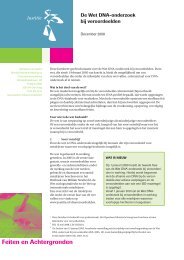INTERPOL HANDBOOK ON DNA DATA EXCHANGE AND PRACTICE
INTERPOL HANDBOOK ON DNA DATA EXCHANGE AND PRACTICE
INTERPOL HANDBOOK ON DNA DATA EXCHANGE AND PRACTICE
Create successful ePaper yourself
Turn your PDF publications into a flip-book with our unique Google optimized e-Paper software.
•basic elements of a dna reportDifferent laboratories vary the format of their <strong>DNA</strong> reports, however quality controlstandards dictate that the laboratory report must include statements that address thefollowing basic elements:• Description of all items received and their packaging, labelling and personal transferof custody of the exhibits from the investigator to the laboratory, and summary ofthe established chain of custody• Description of evidence examined• Methodology used for examination• Scientific screening of items and the testing of Short Tandem Repeat loci (STRs)and an explanation of Polymerase Chain Reaction (PCR).• <strong>DNA</strong> Results• The STR loci examined and the alleles detected are normally listed as a seriesof numbers representing the different forms of <strong>DNA</strong> (alleles) detected.The profiles themselves may or may not be reported in the laboratory reportbut the outcomes and conclusions from the testing will always be reported.• If the quality is sufficient, the profiles will be forwarded to the <strong>DNA</strong> Database.This will often not be possible when mixed stains or very low amounts of stainsare detected. These samples can often be used for a direct comparison at a laterstage when a suspect is found.• Interpretation of results inconclusive• An inconclusive - <strong>DNA</strong> report in which the suspect is neither excluded norincluded can occur due to insufficient <strong>DNA</strong> being present in the exhibits or thepoor quality of the evidence. Inconclusive results also can occur if the evidentiarymaterial contains a mixture of <strong>DNA</strong> from several individuals, for example a rapecase involving multiple assailants, which prohibits interpretation.• No <strong>DNA</strong> or Insufficient <strong>DNA</strong> - The absence of <strong>DNA</strong> from the evidence maybe because there is no <strong>DNA</strong> deposited (such as the use of a condom during arape), insufficient <strong>DNA</strong> present in the exhibit, the <strong>DNA</strong> is degraded, or due tothe presence of factors that inhibit the PCR amplification and subsequent analysisof the <strong>DNA</strong>. A negative result is not equivalent to an exclusion result, as it onlymeans that <strong>DNA</strong> was not detected in the exhibit tested.• Statement on the Deposition of Evidence• The evidence is packaged and returned to the submitting agency or it may havebeen consumed during the analysis.INTERPRETATI<strong>ON</strong> OF THE <strong>DNA</strong> PROFILE PAGE 33







